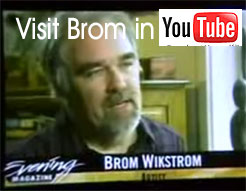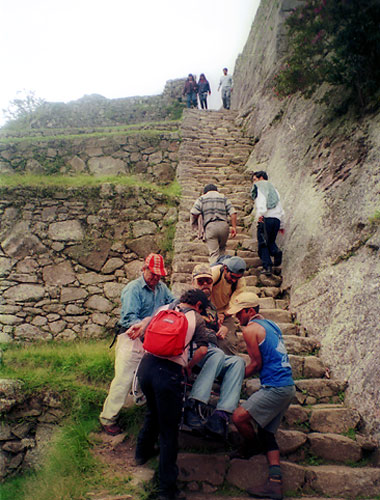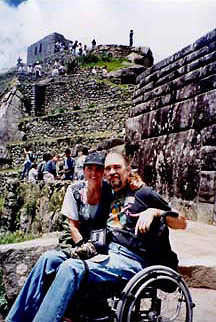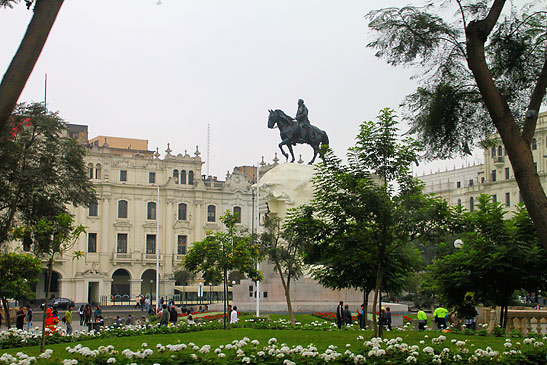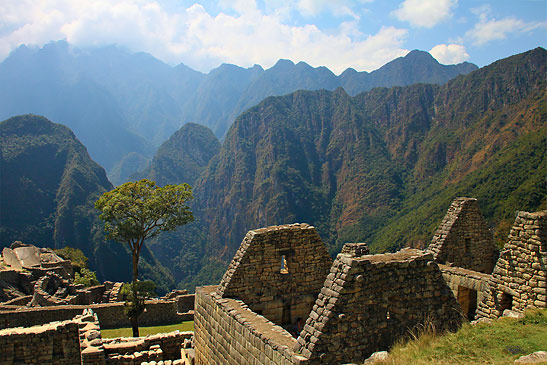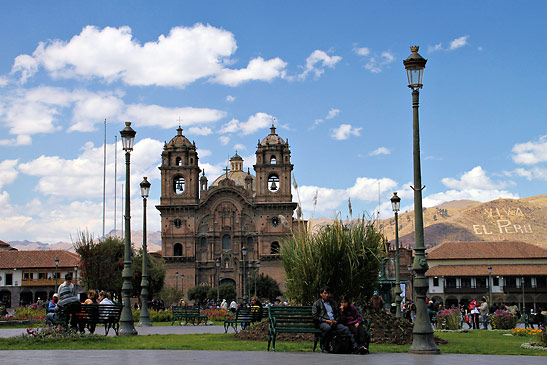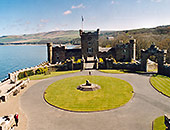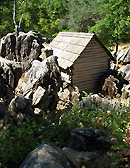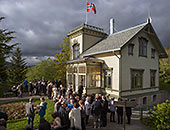 |
 |
|
 |
Visit
Brom at:
www.bromwikstrom.com.

|
Lima, Machu Picchu,
Peru –
A Look Back December '98 By Brom Wikstrom
It will strain us financially but an adventure of this nature is too good to pass up and we are excited about the prospects of meeting artists and experiencing a completely different culture. A couple weeks of arrangements by phone, fax, e-mails and letters go by and we are booked and registered. Anne’s employer has given us the name of a colleague in Lima where the conference is taking place in case of an emergency. Anxious weeks go by as we await our departure and research Inca history that we are certain to experience. We won’t require inoculations but are uneasy about encountering Shining Path guerillas or bandits of any sort. As we approach our departure time we feel as prepared as we can be but do have apprehensions about the unknown. It’s a long flight to Lima and we’re unsure what day it is when we finally touch down but know that it’s late at night and with little effort we get through customs and locate our transportation. It’s apparent as we try to communicate with the cab driver that the language barrier is going to cause difficulty but fortunately we connect with delegates from Tucson who speak the lingo. Frank is blind and an accomplished singer and musician and his companion Marcia operates a theater company and is associated with VSA Arts.
After a few hours sleep, we rise for a quick bite in the hotel café and link with Frank and Marcia and volunteers from the sponsors for a tour of the city. We arrive at Plaza de Mayo, the main city square where the changing of the guard is in progress. It’s a ritual that doesn’t interest us much and we’re satisfied to tour a few shops and listen to the street performers. Frank tries out a flute and joins one group briefly for an impromptu concert. We load into cabs and drive to the district of Miraflores and a large outdoor market. We are stunned by the vast assortment of items for sale and the high quality of the material. Some serious shopping ensues and I pick up a couple of items to add to my collections including a marvelously etched gourd. We walk back to the hotel along Arequipa Avenue that is a wide boulevard that shows the flavor of the city well. The congress is taking place at another hotel that is close enough for us to walk to and we enjoy exploring the neighborhood and getting our bearings while making our way there. The main thrust of the conference is theater arts and I’m thankful to be able to represent a visual component along with a talented artist from Cuba. Delegates gather and we meet many of the participants including Sharon and Laurel who are disabled travel agents from the U.S. They introduce us to a local guide named Pepe who assures us that it will be possible to take a side trip to Cuzco and Machu Picchu! It will further tax our resources but we’re game for the adventure and put our faith in Pepe’s company, Apumayo Tours. The conference consists of a series of panel discussions that are informative and compelling and describe programs offered locally and internationally for people with disabilities to become involved in the arts. We are pleased to contribute to the proceedings and share our experiences. Our evening is capped by a series of wildly confusing but very dramatic performances by conference artists at a theater in another district. The language barrier is formidable but we enjoy the show nevertheless and continue to meet other delegates including Jose, an artist’s agent who has a special treat for us tomorrow. First we will again attend conference sessions but soon rendezvous with Jose, Sharon and Laurel at a local restaurant for lunch. There we taste the national drink, Pisco Sours that resembles a margarita with a froth of egg white and sprinkled bitters. Jose is post-polio and gets around on crutches and upon concluding our trip we will ship him a sports wheelchair that I was no longer using. Our cab follows his car to the Callou District that overlooks the Pacific Ocean and enters a fairgrounds park that is between events. In a secluded area we get out to tour a large studio with an amazing collection of life casts of North and South American Indians. Dozens of the sculptures line a long gallery and a workshop demonstrates their production. Our private tour is also highlighted by a visit to the personal menagerie also maintained by the absent owner who is a friend of Jose’s, a certain Mr. Filipe Lettersten. After the next day’s congress we make our way to the Lima Museum of Art. It is located in a lush park and I only need a little help up five steps to access the galleries. The permanent collection of paintings and sculpture is nice enough but the abundant archeological treasures blow us away. The age and condition of the ceramics and textiles of the pre-Incan cultures demonstrate a high degree of proficiency and we’re hard-pressed to think of these artisans as primitive in any way. The Chancay society is featured in a special exhibition that is dominated by a huge unwrapped funeral bundle that must contain many priceless personal effects of the owner. Our afternoon is capped by a return to the market in Miraflores and gift purchases for loved ones at home. The evening’s performance features a deaf mime from Germany and an incredible piece by a group from Spain whose energy and colorful costumes delight and inspire us all. On our late-night drive back to the hotel young beggars at a red light descend upon our car and thrust their arms into the car for a handout. The last day’s sessions are short and sweet and we take our time saying farewells and exchanging gifts. The many volunteers have been extremely helpful in making our trip easy and I give out many lapel pins that I have had made with an original design. Our next stop is the National Museum. It is a rather ugly, totalitarian looking building but within are delicate glories that span time and space. The exquisite gold and turquoise carvings are incredible and the variety and richness of the ancient material is truly astounding. We are obliged to get assistance up several flights of steps to the main galleries since it’s a Sunday and the elevators are inoperative. The trouble is well worth it as the special exhibit on the Lords of Sipan is incomparable and even features real skeletons. The collection now has its own museum near the site of the discovery. Early the next morning, we rise and load into a cab that takes us to the airport. Our short, first class flight to Cuzco crosses magnificent scenery of deep, jungle ravines and high, mountain plateaus. It is a fabulous scene and we are amazed at our good fortune.
We touchdown in the Inca capital and immediately are ushered to a nurse’s station in order to check my blood pressure for signs of altitude sickness. No problems are detected and we meet with Pepe who introduces us to our porters and tour guide. Edgar is a full-blooded Quechua Indian and relates many facts about his proud heritage. I’m loaded into a van and begin with a tour of the city. Flute music issues from shops on the Plaza de Armas where we stop and have our first taste of coca tea. This beverage will aid in our adjustment to the altitude and the required ritual lends a spiritual aspect to its consumption. Blowing the vapors to the winds and sprinkling a few drops will appease the ancestors and we begin to realize the depth of faith exercised by the Christianized Incas. Anne explores some markets and I chew on coca leaves and admire the Inca stonework that serves as the foundation for Spanish style architecture. The number three figures prominently in the ancient culture and is evident in the steps and recessed doors of the buildings. It is also reflected in the tenets of proper living as described by Edgar; Don’t be a liar, Don’t be lazy, Don’t be a thief. We drive out of town and stop briefly at the enormous, stone fortress of Sacsahuman and Tambo Machay with its cascading waters that only the nobility could use. Edgar points out the terraced mountain fields that the Inca had constructed into the shape of a condor on our way to the small but historic town of Pisac. We purchase some modest souvenirs and continue our drive into the Sacred Valley to our hotel, the Posada del Inca. The altitude is getting to me a bit and I am pleased to lie down for a nap before a light chicken and rice meal. We are pleased to visit a small chapel on the grounds and later are treated to a fireworks display ignited in celebration of tomorrow’s Feast of the Immaculate Conception. Later that evening, we visit a ceramic studio and meet the English-speaking owner. The work is wonderful but a little pricey and we really don’t have room in our bags so only purchase a small plaque. We are too excited about tomorrow’s adventure to get much sleep and will have to rely on adrenalin to get us by. I enjoy a hearty breakfast and feel prepared for the day. It is a glorious, sunny day and we load and begin our drive towards the train station that will transport us to the Machu Picchu station. Along the way, Edgar points out the way Inca women rouged their lips with crushed cactus mites that generated a red substance. He also shows us a whole mountain that had been converted into the form of a frog with more stone terraces. Folk artists offer us their products while waiting for the train that will carry us along the banks of the Urabamba River. Farmland gives way to ever-increasing jungle growth the further we go and the gentle river becomes a torrent as we descend deeper into the gorge. Edgar points out evidence of Inca civilization along the way and describes the rail line as a previous Inca trail. Several passengers get off at the halfway point to walk the rest of the way to the citadel. The first of several obstacles greet us as we exit the train at Machu Picchu station. Steep steps lead to the buses that will take us to the park so we are obliged to traverse a long rocky trail instead. My porters take turns and team up for the hard parts and manage to get me aboard the bus that takes us up a harrowing twelve-kilometer drive to the site. Edgar is clear in his correction that these are not “Ruins”, and that Hiram Bingham was the Re-discoverer of the city.
He also makes a dramatic declaration about the mountain that overlooks the city after we have entered the sacred confines. The shape of the Puma Mountain becomes apparent and certain mysteries are revealed as we delve deeper into the extinct civilization. The manicured stonework is extremely impressive and our eyes take in the wonders with majesty. A long flight of steps leads to the most sacred place, the Temple of the Sun. While my helpers take a well deserved break, we listen to Edgar’s description of the edifice. I decide to place one of my pins beneath a stone and Edgar makes the gift worthy by raising his arms and begging acceptance of the Inca. We ascend another long flight of stone steps to the Sacred Plaza and take in the awesome view through the Temple of the Three Windows. This courtyard is the site of many ceremonial rituals that I cannot begin to imagine and I express my sincere gratitude to Pepe and the others who have made this remarkable experience possible. The weather is hot and I begin appreciate why the sun and the shadows it casts were of such significance to the Inca.
Anne is able to access other parts of the site while I find a shady spot and let my imagination carry me aloft, above these massive, unspoiled stones and into the cloud jungle. The large, ceremonial plaza below is easier to traverse and Anne and I get a few moments alone to reflect on the meaning for both of us. Too soon though, we rendezvous and after some group photos, we begin our descent. A mild shower cools our sunburned brows and gives a shine to the rocks and cliffs as we move along the terraces that lead towards the exit. We pass under an enormous stone outcropping that serves as an effective barrier to this Shangri La. The bus-ride back gives me a lingering view of the palaces and we feel as if waking from a dream. We have a 3/4 of a mile trek along the rail line to the helicopter port and eventually get hoisted aboard the twelve-seat helicopter for the half-hour flight back to Cuzco. The other fellows will take the train back and meet with us over a congratulatory dinner at a restaurant off the Plaza de Armas. We check into the Hotel Libertador, a luxurious place but not very accessible and relax over a late lunch with Pepe and some Coca tea. That evening on the plaza, we treat to a well-earned meal and express our thanks for the crew’s hard work on our behalf. We stay up late and review the experience over champagne in our room and say our farewells. It has been an extraordinary day that we will never forget and we’re sorry to see it come to an end. Anne has a raging headache upon rising and even inhales oxygen once we’re aboard our flight back to Lima. Our familiar cab driver is happy to see us and takes us back to the Invertur Hotel where I am pleased to rest in bed while Anne visits the shopping market one last time and acquires several musical instruments. That evening, Dr. Haro, a colleague of Anne’s boss, treats us to a fantastic meal. He is interested in the work I’ve recently had done on my teeth and gives me a cursory exam in the middle of the dining room to the amusement of the waiter. The long flight back to reality is mercifully uneventful
and we are delighted to return safely. We share our memories with our
loved ones and present them with gifts that have much more meaning for
us and begin to re-assimilate back into the twentieth century. |
|
Let Brom know what you think of his Bavarian adventure. Brom, Your article was enchanting and enlightening. It is so important that people understand the variegated requirements of-every-traveler. The world belongs to all of us and must be barrier-free. Your vivid depictions allow your readers to journey with you. Many thanks and best wishes, --- Gabriella, Raleigh, NC Hi Gabriella, Thank you for your kind remarks. It is important to put a face to barrier free travel and i'm glad you share my concern. Best regards, --- Brom
Brom, Your story of your Tuscany experience made my heart sing. In March-April 2008, my husband and I rented a villa (a house actually) in a 1,000 year old hill top village, called Rodicondoli. It is owned by San Diego friends, and it was our second experience there. We mingled with the local, enjoyed their very active village life and were only 35 minutes from Siena. If you have not read it, I HIGHLY recommend one of the funniest books on Tuscany, written by a tour guide, Dario Castagno and titled, "Too Much Tuscan Sun". Each of the 6 visitors we had there read it and roared. One of the owners of our house, Casa Illuminata, is Ron Miriello, who has developed a friendship with Dari. When one can CAN communicate in Italian, things happen more quickly.It was so rewarding to know that a wheelchair did not get in the way of your enjoying this grand area of Italy. Good for you and your wife for forging ahead. --- Grace Micetich, San Diego, CA
That was incredible. I just got back from a business trip to Munich and Hamburg and can only imagine how difficult it must be to travel around Germany in a wheelchair. Kudos to you Brom for your article ... and to you Ed, for making his story known.
|
|
| ||||
|
| ||||
This site is designed and maintained by WYNK Marketing. Send all technical issues to: support@wynkmarketing.com

|

